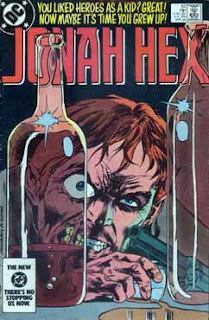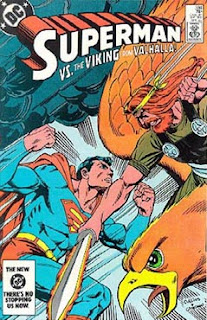The interesting story, though, is the second one by Kraft and Mazzucchelli/Rodriquez which serves as a coda to the Pantheon saga that concluded in issue 300. As the other heroes depart, Batman asks Superman if he'd like to get a drink with him. The two go to a pub full of African colonialist scum and villainy and a couple of them don't believe these funnily dressed strangers who order milk and talk about their feelings are real superheroes and decide to challenge them. Humorously, the two heroes defeat the tough guys without leaving their seats and only barely disrupting their conversation. The strange thing about this story from the modern perspective is seeing Batman talk to his friend about his feelings. He references his loneliness and concern that the two of them seldom get to talk because they are always dealing with some crisis. I can't say Kraft's script completely sells me on it, but it's kind of refreshing to see a time where friendship was important to these characters.
Wednesday, January 29, 2025
Wednesday Comics: DC, April 1984 (week 4)
The interesting story, though, is the second one by Kraft and Mazzucchelli/Rodriquez which serves as a coda to the Pantheon saga that concluded in issue 300. As the other heroes depart, Batman asks Superman if he'd like to get a drink with him. The two go to a pub full of African colonialist scum and villainy and a couple of them don't believe these funnily dressed strangers who order milk and talk about their feelings are real superheroes and decide to challenge them. Humorously, the two heroes defeat the tough guys without leaving their seats and only barely disrupting their conversation. The strange thing about this story from the modern perspective is seeing Batman talk to his friend about his feelings. He references his loneliness and concern that the two of them seldom get to talk because they are always dealing with some crisis. I can't say Kraft's script completely sells me on it, but it's kind of refreshing to see a time where friendship was important to these characters.
Monday, January 27, 2025
Greyhawk: The Horned Society
The origin of the so-called humanoids of eastern Oerik is something of a mystery. They first entered history as mercenaries and foederati of the Suloise and Baklunish in their wars. When the conflict toppled both empires, the humanoid groups fell upon their former patrons as well as their enemies as every people scrambled for their own survivable. A confederation of hobgoblin comitatus and various allies of other humanoid groups settled in the steppe north of the Nyr Dyv between the Veng and Ritensa Rivers.
In recent decades, one or more high priests of a diabolic cult have managed to convert the fractious tribes and bring them under their sway, forming the Horned Society. While the name is applied in human lands to the region, only a portion of the humanoid tribes residing there are actually directly in the service of the Horned Society Hierarchs. Though much has been made of the superstitious fanaticism of humanoids, it seems likely that the Hierarchs rule as much by their success in delivering lucrative plunder through banditry and by canny manipulation of rivalries between groups. The theatrics employed by the Hierarchs, to say nothing of the invocation of diabolic power, likely serve as a deterrent against would-be usurpers, however.
Friday, January 24, 2025
Weird Revisited: Magical Revolutions
We’re all familiar with the advance of technology and the shifting--sometimes radically--of scientific ideas. The ether theory gave way to special relativity; the crossbow gave way to the gun. So why is it we seldom see any advancements in the technology of magic, or magical paradigm shifts, in rpg settings?
Not that magic isn’t shown as changing over time, but it's almost always a fall from a more advanced state, even a Golden Age, to its current one. Mostly, though, this seems to just a change from more magic to less. Sure, this gives a convenient rationale for ancient magical ruins and magical items laying around, but there are other explanations for that stuff, surely.
Why can’t magic missiles be more powerful today than 100 years ago? Maybe old spells have completely fallen by the wayside due to improve defenses (maybe, though, those defenses have been lost too?). Or how about old magical theories giving way to the radical new theories of a Magus Einstein? Different magical schools/styles need not be equally valid views that just add “color”, one could be more true than the other. What would that even mean: more powerful spells? shorter casting times? higher levels attainable? bragging rights in the outer planes?
Wednesday, January 22, 2025
Wednesday Comics: DC, April 1984 (week 3)
Monday, January 20, 2025
Crunch and Complexity
Last week, consideration of the new HârnMaster: Roleplaying in the World of Kèthîra and a blog post I came across in defense of heavy rules sets got me pondering what constitutes complexity and/or crunch in a rpg. Though the terms are often used interchangeably, I feel like it might be worthwhile to differentiate them.
Complexity I think speaks to the level of detail. Games tend toward greater complexity when they have one or more of the following:
- Multiple rule subsystems/exceptions to standard mechanics
- Multiple rolls required to resolve tasks/events
- Larger numbers of character qualities, particularly when they each have their own mechanics
- Figured/derived characteristics needed in play
- Tracking of multiple characteristics/variables
- Required consultation of charts
So what's crunch? I had initially thought of it essentially as math related: quantization, calculation, use of formulas, etc. Discussion with Ian of Benign Brown Beast made me reconsider. He viewed crunch as "character builds, optimal play, and interaction with the rules on their own terms (as opposed to thru the fiction)."
"Optimal play" and "interaction with rules on their own terms" are about approaches to systems, not the systems themselves, so I think those are separate phenomena. Perhaps they are a signal for the existence of crunch, though? Melding Ian's thoughts and my initial ones, I now think crunch relates to number of mechanical decision points within a system. This would show up on the player-facing side as character creation and tactical options, resulting in the potential for optimal builds in games like 3e D&D or Lancer. It also shows up in games intended to "realistically" (or at least consistently) model a wide range of genres or setting elements, like Hero System or GURPS.
In this way of viewing things, crunch can (and does) lead to complexity, but there are also factors that would lead to lengthier procedures but not necessarily options or decision points.
Friday, January 17, 2025
Two Lawful Neutral Religions
My "Hidden Religions of D&D" posts got me thinking about a new way to view alignment in D&D, and that is not as personal ethics or even (necessarily) cosmic forces, but rather as placeholders for religions within a campaign setting. Old D&D gives us some detail on the generic "Church of Law" so it would be interesting to expand that idea to other alignments--however many one wants to use.
A Lawful Neutral church would be one that holds to the supremacy of cosmic order. They would focus on the duties of individuals and society to uphold and harmonize with that cosmic order. Here are Lawful Neutral faiths that would represent these ideas in different ways.
Universal Harmony
This faith believes there is an Eternal Order that has always existed on some idealized plane, but through the process of Law that encompasses both the working of the cosmos and the virtuous behavior of the beings with that cosmos, must be made manifest. The obligations of the humanity in this work are laid out in the religion's holy text, the Formicarium.
The common person is urged to be content with their roll in life and work to make society as whole more orderly and harmonious. The contemplation of greater mysteries is left to ascetics who sometimes provide guidance on important issues to the communities they serve. Those involved in the legal system and the formulation of laws are likewise members of the clergy as law flows from and is a facet of perfect cosmic Order.
The Formicarium mandates that the ruler of a state should be a dispassionate vessel for law. Their job is to insure those under them proceed with honest and transparency, and punishment for transgressing the law is swift and impartial.
Upon death, adherents look forward to an ultimate oneness with the universal process, so that they neither suffer nor desire.
Zurthonism
Zurthon is viewed as the first principal, the transcendent god of time, space, and fate. Zurthon is sometimes called a "machine god"--a being without passion or compassion, and above concepts of good and evil. The faithful seek to divine the path Zurthon has predetermined for them from the beginning of the universe by the study of the Heavens. Zurthonist astrologer-priests plot a child's horoscope from birth. The faithful do not seek to avoid or change ill-fate but rather use this for knowledge to allow them to prepare for the future, the better to display their submission to Zurthon's divine plan.
There are heretical sects of Zurthonism that view predetermination as an excuse for licentiousness or abandon (and thus become a cult of Chaotic Neutral), but orthodox belief promotes a stoicism in all things.






































